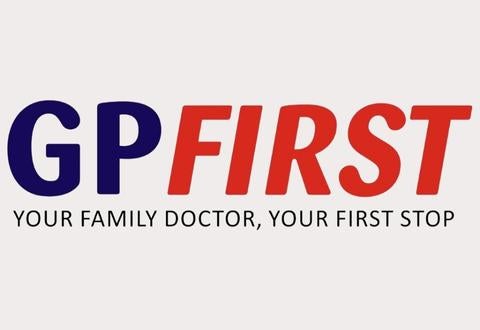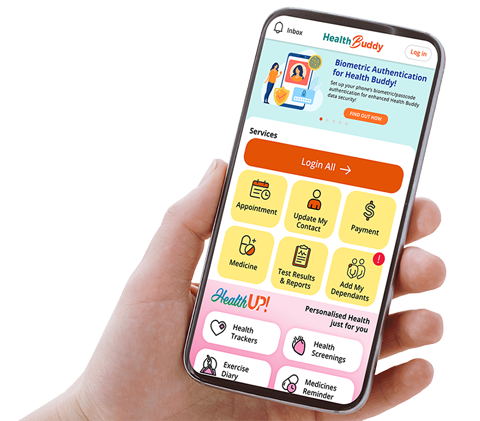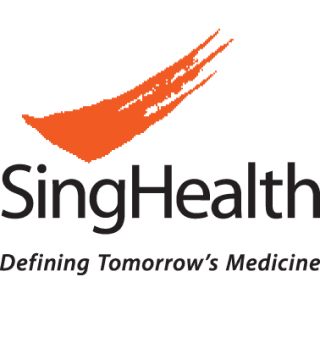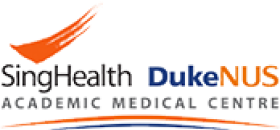1923
The British decided to build a new naval base in Changi.
1935
The Royal Air Force Hospital was commissioned. The physical growth of the naval base in Changi between 1934 and 1941 was accompanied by the development of its welfare facilities, including the Royal Air Force Hospital. During this period, the Engineers held cinema shows twice weekly in H Barrack Block, where the hospital was.

The old Changi Hospital building.
1942 to 1945
During the war, Changi Naval Base became a Prisoner of War (POW) camp. During this period, many POW’s died of dysentery and other diseases. This was more than what the hospital could cope with.
Within a fortnight of the British surrendering, the hospital moved to Roberts Barracks which was rapidly converted into a gigantic sick bay. Block 126 became the operating theatre and Block 128 became the isolation wing for diphtheria cases. Blocks 144 and 151 were converted into the dysentery wing, with a temporary building nearby serving as the mortuary.
Roberts Barracks was still too small to cope with the number of patients who needed hospital treatment, so the Australians in Selarang set up their own hospital for 2,000 patients in the Officers’ mess and one of the barrack blocks.
1950s to 1960s
After the end of the Japanese Occupation, the hospital returned to its original location on Far East Air Force Hill (F.E.A.F Hill), Blocks 24 and 37. More buildings were added to expand the hospital to cater for all the Royal Air Force (R.A.F) stations in Singapore. This was done by linking them with a new building (161) in 1962.
1965 to 1974
With the gradual withdrawal of British troops after Singapore's independence in 1965, the Royal Air Force (RAF) Hospital went through a series of name changes under different administrations. When it was handed over to the newly formed Commonwealth forces of Australia, New Zealand and United Kingdom, it became known as the ANZUK Hospital. Upon the disbanding of ANZUK, the hospital was renamed the UK Military Hospital.
January 1975
Changi Chalet Hospital on Halton Road started admitting patients. Located at a former British officer’s club on Halton Road about 100 metres away from the UK Military Hospital, it provided emergency services to holidaymakers who had minor accidents or to people with other minor medical complaints.
Changi Chalet Hospital also provided X-ray and laboratory services to patients from the nearby Changi Prison Hospital and polyclinics on Pulau Tekong and Pulau Ubin. It also cared for SAF personnel and convalescent patients from other government hospitals. The Changi Chalet Hospital had 36 beds, an operating theatre, an X-ray and laboratory facility and an emergency unit.
December 1975
The UK Military Hospital was handed over to the Singapore government as the British troops completed their withdrawal from the region and the hospital was renamed the Singapore Armed Forces Hospital. The hospital initially provided free medical care for SAF personnel and their immediate family members. One nursing officer and 14 staff nurses were seconded to the hospital from the Ministry of Health.
Its services were extended gradually to members of the public, charging them at the same rate as other government hospitals. The services provided then included A&E, general surgery, general medicine and dental surgery.
July 1976
The Singapore Armed Forces Hospital combined with the Changi Chalet Hospital to become ‘Changi Hospital’ which was then handed over to the Ministry of Health. Changi Hospital comprised an Upper Block at Halton Road and a Lower Block at Turnhouse Road. It had 180 beds and provided general medicine, general surgery, dental surgery and 24-hour Accident & Emergency services. Minor orthopaedic conditions were followed up at the weekly Fracture Clinic.

Nurses at the main entrance of the old Changi Hospital.
January 1997
Patients from Changi Hospital were moved to the New Changi Hospital and Changi Hospital shut down its operations.

The old hospital buildings in the present day.
1960s: Building Our Reputation
To meet the growing demand for medical services, the government decided to build a new hospital for the chronic sick at Thomson Road. The foundation stone of the Thomson Road Hospital was laid down in June, 1957. The hospital was set up to accommodate spill over patients from the Sepoy Lines General Hospital and was formally opened on 20 May 1959 with only two doctors, seven nursing staff and one commissioned ward.
The hospital also went on to build an excellent reputation for postgraduate training. Well-known physicians practicing in Singapore and overseas received their postgraduate clinical training at the hospital. Nursing training was also formalised when the School of Nursing for Pupil Assistant Nurses officially opened within Thomson Road Hospital in September 1965.
Clinical research was also undertaken during our initial years. Professor Seah, together with Dr Chua Kit Leng and Dr Jayaratnam, were the first to discover the presence of tropical sprue in Singapore and to fully document this research. Professor Seah and Dr Chua also pioneered the first flexible gastroscopy procedure in Singapore.
In the 1960s, the patient load gradually increased and new facilities such as a surgical block and an X-ray department were added. We also started offering neurosurgery in 1965 and obstetrics and gynaecology in 1969. As the hospital took on more responsibilities, its role as an acute hospital offering a wide-range of medical services was recognised in 1968 when it was renamed as the Thomson Road General Hospital.

One of the buildings of Thomson Road Hospital.
1970s: Pioneering Research & Pilot Projects
The hospital continued to grow as we introduced new clinical specialties such as neonatology and orthopaedic surgery. The Department of Anaesthesia, headed by Dr V Sivagnanaratnam, who later pioneered the thoraic epidural band block technique for postpartum sterilisation was also formally established in 1971. More distinguished doctors also joined our ranks. This included Prof Lee Yong Kiat, who was appointed the hospital's Chief of Medicine in 1971.
In the 1970s, our X-ray and Accident & Emergency (A&E) departments implemented 24-hour operations. The hospital also improved its bed arrangements, providing for greater privacy and comfort. It was the first hospital to introduce B2 class wards, a pilot project of the government medical service.
During this decade, our doctors continued to be involved in research in the areas of lactose intolerance, gastro-intestinal bleeding and peptic ulcer.
In 1975, we were renamed Toa Payoh Hospital, after the newly built satellite town that we served. This name was kept for the next 21 years.
1980s: Rapid Growth & Expansion
The 1980s were characterised by rapid growth and expansion. Professor Lee Yong Kiat was instrumental in developing the hospital's medical services. The A&E Department underwent a face-lift—air conditioning was installed, two operating theatres were refurbished and the department was computerised to facilitate registration and the retrieval of information. In 1985, the hospital began concentrating on two key specialisations—Urology and Gastroenterology.
In the ‘80s, the hospital found itself operating at full capacity to cope with increasing numbers of patients from the surrounding New Towns including Toa Payoh, Ang Mo Kio, Yishun, Serangoon and Bishan. The hospital administrators soon started to look for suitable grounds to build a bigger and better hospital. Many sites were considered, including the land adjacent to the hospital but after much deliberation, a new site in Simei was decided upon.uild a bigger and better hospital. Many sites were considered, including the land adjacent to the hospital but after much deliberation, a new site in Simei was decided upon.

Entrance to the TPH A&E.
1990s: Restructuring & Relocation
This was a significant era for the hospital. Restructured on 1 April 1990 and through corporatisation, a new Toa Payoh Hospital logo was unveiled alongside the mission statement and corporate philosophy. The hospital also embarked on new programmes to improve service and care. To encourage staff to achieve a high standard of quality care, the hospital developed a unique Quality Statement: "To provide a level of patient care and services good enough for our own mothers without the need for special arrangements."
More medical services were provided with the introduction of the Ear, Nose and Throat (ENT) department in 1994 and the Eye department in 1996. Within a year, it became the second busiest hospital in Singapore.
Through the efforts made to improve service and care, patient load increased to maximum capacity in mid-1990s. This left the hospital with no choice but to transfer patients to other hospitals due to bed shortage. It was interesting to remember our beginnings as a hospital receiving overflow patients from other hospitals.
Subsequently, Toa Payoh Hospital closed on 15 February 1997 while staff and patients were moved to the new hospital in Simei.

1997
Toa Payoh Hospital and Changi Hospital merged to become the New Changi Hospital, and was later renamed Changi General Hospital (CGH). It operated a custom-built general hospital facility in the heart of eastern Singapore at Simei, with a then-capacity of 801 beds.

1998
Changi General Hospital was officially opened on 28 March 1998 by then Deputy Prime Minister Lee Hsien Loong. At its opening, it had a wide range of specialties including general medicine, general surgery, orthopaedic surgery, geriatric medicine, rehabilitation medicine, psychiatry, ENT and eye, and sub-specialties in gastroenterology, cardiology and urology.

2000s
The CGH Geriatric Centre offers one-stop services for elderly patients.CGH launched new clinical services in sports medicine, dermatology, psychological medicine, rheumatology and neurosurgery.
It opened a one-stop Diabetes Centre and established the largest multi-disciplinary sports centre in Singapore, the Singapore Sport & Exercise Medicine Centre @ CGH, catering to both recreational and competitive athletes.
In 2004, CGH opened a new Geriatric Centre that houses both the Specialist Clinics and the Geriatric Day Hospital, offering the convenience of a one-stop service for elderly patients.

The CGH Geriatric Centre offers one-stop services for elderly patients.
2011
CGH became a founding member of the Eastern Health Alliance, a regional health system to provide seamless, quality care for eastern Singapore.
2012
CGH opened the Centre for Innovation, a platform for healthcare technology translation; and the Changi Simulation Institute, an integrated simulation training centre for healthcare professionals.

The Changi Simulation Institute.
2014 to 2017
CGH launched a series of programmes to right-site and ensure continuity of care.
CGH’s GPFirst programme encourages residents in the east to visit their General Practitioners first for mild to moderate conditions. CareLine, a personal care telephone service, provides 24/7 health and social support to vulnerable seniors in need of urgent assistance while keeping them safe and healthy at home. The Health Peers Programme is a partnership with community stakeholders and government agencies to encourage residents to lead healthier lives.
2015
The Integrated Building (IB), jointly run by CGH and St Andrew’s Community Hospital (SACH), was opened, providing a new model of care to optimise rehabilitation for patients.

The CGH dementia ward is one of the unique care facilities at the Integrated Building.
2018
CGH joined the SingHealth Duke-NUS Academic Medical Centre (AMC) family as part of the nation’s reorganisation of the public healthcare system into three integrated clusters, to better meet Singaporeans’ future healthcare needs.
CGH’s new Medical Centre is opened, enhancing specialist care by providing care to patients with complex medical conditions in a more integrated way.

The CGH Medical Centre provides enhanced specialist care for patients.
2019
CGH set up the Changi Aviation Medicine Centre, Singapore’s first aviation medicine centre within a government restructured hospital, offering customised care for pilots, cabin crew and air traffic control staff.

2021
The Shimadzu-CGH Clinomics Centre, opened by Deputy Prime Minister and Coordinating Minister for Economics Policies Mr Heng Swee Keat, conducts mass spectrometry-based clinical testing and research supporting personalised treatment, for better clinical care for patients with hypertension and other chronic diseases. Read the press release here.

The Shimadzu-CGH Clinomics Centre conducts research to better clinical care for patients with hypertension and other chronic diseases.
The CGH Wound Healing Centre, a one-stop multi-disciplinary centre to provide early interventions and outpatient treatment of chronic wounds, was opened by then Senior Minister of State for Health and Manpower Dr Koh Poh Koon. Read the press release here.

The CGH Wound Healing Centre provides easy, fast-tracked access and convenience for patients with non-healing wounds.
2022
CGH developed partnerships with academic and industry partners such as Changi Airport Group and CapitaLand, to advance health, wellness and innovation beyond the hospital for various communities. Read the press release here.

CGH continues its culture of care for patients over the years.
2023
CGH celebrated 88 years of clinical excellence and trusted care with a series of landmark events. The CGH Community Mural, unveiled by then-Deputy Prime Minister Heng Swee Keat, and fellow East Coast GRC Advisers, Senior Minister of State Mr Tan Kiat How, Ms Jessica Tan and Ms Cheryl Chan; is Singapore's largest community mural made of photobricks under the Singapore Book of Records, and symbolises the collective strengths and efforts of CGH and its valued partners and volunteers in contributing to better health and healthcare for the community. Read the press release here.

The CGH Community Mural set a Singapore record for the largest photobrick mural, measuring 6m-by-2.8m and made up of 264,292 photo-bricks.
CGH introduced robots to augment the care team at the Emergency Department to take on heavy medication loads, make repetitive trips, and provide wayfinding and blanket delivery services, with an aim to increase efficiency and productivity, and enhance experience for patients and visitors. Read the press release here.


Robots at the CGH Emergency Department assist with wayfinding, medication and blanket delivery.
CGH also pioneered the Pharmacy Smart Interface System (PharmaSIS), Singapore’s first smart vending machine for pharmacy-only medicines by providing on-site tele-consultations with a pharmacist for timely and convenient access to medicines. A range of over-the-counter medicines are also available round-the-clock at the machine. Read the press release here.

PharmaSIS smart vending machine allows patients to purchase pharmacy-only medicine after teleconsultation.
2024
Empowering seniors to take active steps towards better health, a new GUINNESS WORLD RECORDSTM title for the Largest Senior Citizen’s Health Awareness Lesson was set at the CGH 88th Anniversary HEALTHFest, which comprised a health awareness lesson outlining the cornerstones for healthy ageing, complemented by a health carnival with screenings for hearing loss and cancer as well as health education in mental health, chronic pain management, falls prevention and vaccinations. Read the press release here.


Attended by 469 seniors, the record-setting 'How to Stay Healthy Over 65' health awareness lesson highlighted key concepts for healthy ageing.
CGH introduced a formal screening programme through its multi-disciplinary Lymphoedema Service to advance lymphoedema care through early diagnosis and a proactive management. Read the press release here.

The multi-disciplinary CGH Lymphoedema Service enables early diagnosis for patients with or at-risk of lymphoedema for improved patient outcomes.
CGH and SMRT forge a partnership to enhance the occupational health and safety of SMRT workforce, leveraging CGH’s occupational medicine expertise. Read the press release here.

CGH collaborates with SMRT to enhance the occupational health and safety of SMRT employees.
2025
CGH commemorates 90 years of care innovation.
CGH officially opens the Singapore Changi Aeromedical Centre (SCAC) to provide clinical and training services for the Republic of Singapore Air Force (RSAF) aircrew, related service personnel, and other commercial clients. An MOU was also signed with the RSAF to collaborate on enhancing aircrew health and performance, fitness-to-fly assessments, aeromedical evacuation protocols and operational training. Read the press release here.

CGH will advance aircrew healthcare, aeromedical research and innovation, as well as specialist training through the SCAC.



















